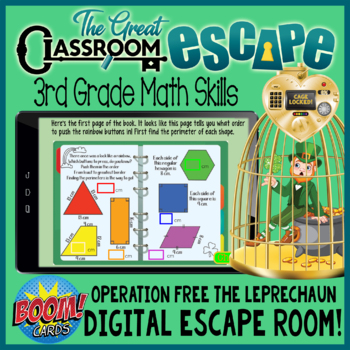3rd Grade Math St. Patrick's Day Digital Escape Room Boom Cards™
- PDF
- Internet Activities
Description
Third grade math skills will be needed to free the leprechaun in this fun St. Patrick's Day digital escape room. Students will be engaged in solving puzzles involving finding the perimeter of polygons, solving multi-step word problems, finding missing factors, and more. Best of all, there are no clues to hide or answers to check; this online breakout is super simple to implement and completely automated by Boom Cards™! This activity is also available in a Google Forms™ version.
To use Boom Cards, you must be connected to the Internet. Boom Cards play on modern browsers (Chrome, Safari, Firefox, and Edge). Apps are available for modern Android, iPads, iPhones, and Kindle Fires. For security and privacy, adults must have a Boom Learning account to use and assign Boom Cards. You will be able to assign the Boom Cards you are buying with “Fast Pins,” (a form of play that gives instant feedback to students for self-grading Boom Cards). For assignment options that report student progress back to you, you will need to purchase a premium account. If you are new to Boom Learning, you will be offered a free trial of our premium account. Read here for details: http://bit.ly/BoomTrial.
In order to complete the puzzles in this escape room, your students will need to be able to:
- Find the perimeter of a polygon
- Solve multi-step word problems using the four operations
- Add and subtract within 1,000
- Round to the nearest ten and hundred
- Multiply a single digit by a multiple of ten
- Solve simple substitution ciphers (substituting a letter for a number)
- Find missing factors or divisors (within 100)
Digital escape rooms are a great way to review material, encourage collaboration, integrate technology, and keep students engaged with a fun, educational activity related to a holiday!
FAQ
- How long will this take? That is the hardest question as the answer varies depending on each classroom, student, or group. Some students with a firm grasp on the concepts covered in this escape room will be able to complete the challenge quickly (30 minutes), but most will take loner. The majority of students will take between 35-55 minutes.
- Will students have to search the web to figure out the puzzles? NO! All of the information needed will be provided in the Boom Deck™. The math in this activity is all standards-based.
- Can this be used for distance learning? Absolutely! Boom Cards™ are great for distance/remote learning or in-class teaching.
This activity is also available in a Google Forms™ version.
See more digital escape rooms based on third grade math standards!





